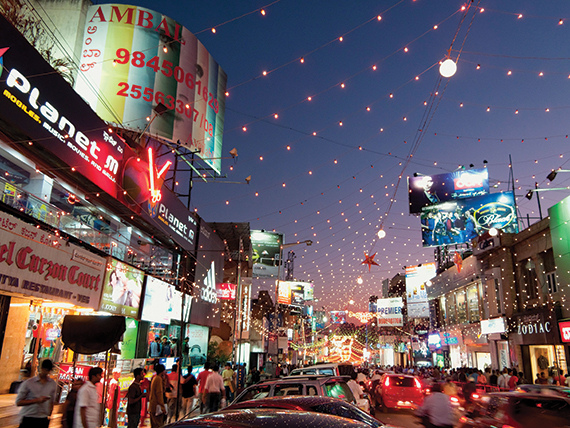Under new laws India has now opened up its retail industry to overseas brands eager to satisfy the desires of its growing middle class. Can the real estate sector supply the space? Helen Roxburgh reports
Two years ago, a ground-breaking law in India opened the country’s retail sector up to international investment.
Historically, Indian retail has been dominated by small, neighbourhood traders; branded retail was virtually non-existent until as recently as the 1990s. A process of liberalisation over the decade gently paved the way for both domestic retail chains and for limited overseas investment, in specific sectors and partnership structures.
Under the changes announced in 2012, the Indian government formally approved up to 51% foreign direct investment in multi-brand retail, and 100% in single-brand retail. This move was generally seen as long overdue. The country has a rapidly growing urban middle class – comprising 160m people, more than the entire population of Russia – that wields increasing levels of disposable cash.
Bringing international supermarkets into India was also expected to help bring down soaring food prices, modernise the country’s distribution and infrastructure systems, and boost food safety standards.
And yet, two years since the rules changed, the penetration of branded Western retailers into the Indian market remains tiny. Why?
One huge factor was a looming election, and a divided coalition government. Various conditions attached to the FDI policy have also raised eyebrows, including one requiring foreign chains to source 30% of their products from local small and medium-sized enterprises.
“Several global brands are already present in India,” says Rashmi Upadhya, associate director of strategy at PwC India. “However, penetration of brands into India remains shallow and non-uniform across segments. There is a significant presence of international brands in categories such as beauty, cosmetics and fashion. But big-box hypermarket retail as a category is under-penetrated owing to regulatory restrictions. Profitability continues to be a challenge for these international players in the Indian context.”
The mix of uncertainties has proved enough to scare off several retailers. In July, French company Carrefour announced it would close its five cash-and-carry stores in India. This was followed by Walmart’s decision last October to dissolve its joint venture in India with Bharti Enterprises and suspend plans to open supermarkets in the country.
“Up to now, the plans of international supermarkets in India have been a total failure”
“The challenges were bureaucratic hurdles, red tape, complicated processes, outdated regulations and most of all corruption – all of which are highly discouraging,” says Purvez Gazder, director at Indian food service consultancy HCTS International. “Up to now, the plans of international supermarkets in India have been a total failure – Tesco, Walmart, Carrefour and the like had huge plans and had committed millions towards their India operations. But none took off.”
Fast-forward to 2014. The election has happened, and the new majority government is being generally pro-active in encouraging international investment. India is still ranked an abysmal 142nd out of 189 countries in the World Bank’s Ease of Doing Business ranking, something the new prime minister Narendra Modi is keen to change.
“What players on the fence were waiting for was for the government to be elected,” says Vivek Kaul, CBRE’s head of retail services in India. “Now this has happened, it is very easy for them to take an informed decision. Since it’s a majority government, there will at last be more clarity on where they are heading. And the new government might even relax certain caveats about investing in the country in the future.”
And assuming the political landscape continues to look favourable, players will enter the market. Some are there already. CBRE’s Expanding Horizons of Global Retailers in India study found that more than 60% of the 300 global retailers surveyed have some form of presence in India. Retailers that have entered the country via joint ventures include Marks & Spencer, Zara, Tommy Hilfiger and Mothercare, while food brands such as Pizza Hut and McDonald’s have formed franchises.
“Following the recent regulatory changes and better market understanding, many companies are now willing to consider a higher level of commitment by buying out the stakes of their local franchisee partners and opting for 100% ownership,” says Upadhya. “The coming years may see more licensing, distribution or franchisee agreements being converted into joint ventures, or foreign players completely buying out their local franchisee partner’s stake.”
UK retailer Tesco has signed a 50/50 jv with Tata Group’s retail arm Trent for its expansion; it is expected to start opening branded supermarkets next year. Marks & Spencer, which formed a jv with India’s largest retailer Reliance Retail in 2008, said in October it was planning to open 38 outlets to take the total number of its stores in India to 80 by 2016.
And Spanish brand Zara, which is also in India through a joint venture with Trent, said in its annual report in July that its Indian operations had seen 43% annual sales growth.
“Where international players have kept prices affordable for Indian customers they have been successful,” says Saurbh Katyal, senior associate director for retail services, west and south India, at Cushman & Wakefield.
But, it is not all smooth sailing from here. A large question mark looms over the ability of India’s retail real estate market to match demand.
A limited supply of land in leading cities and a lack of active planning or intervention from the government mean the country’s retail sector growth has been scattergun. The 2008 financial crash also decimated the retail development pipeline in the country, which didn’t start to tick back into action until 2011.
Among India’s 300-plus malls, only a few can be described as “successful” retail projects, according to CBRE’s report, and 70% of that space is in New Delhi, Mumbai or Bangalore. India has close to 54m sq ft of retail space, but successful malls account for only about 4m-5m sq ft.
And further compounding this issue of limited space are very high rents and a lack of professional mall management, all of which make for a challenging operating environment.
“International retailers are looking for well-located, well-designed and well-managed malls with great traffic, good transport links and a good mix of international tenants,” says James Hawkey, managing director of retail services in Asia Pacific at Cushman & Wakefield. “Mumbai, New Delhi and Bangalore have some good retail developments and more shopping centre development is happening in tier 2 and tier 3 cities, but there is still room for more high-quality space.
“In India, as in any emerging market, developers are still learning.”
Retailers might also need to adjust their store planning to fit the Indian market.
“Successful malls in India account for only about 8-10% of the total retail stock,” explains Upadhya. “The rest is comprised by second-grade malls, which international retailers prefer not to invest in. This indicates inefficiency in mall development and management. Hence, good-quality real estate is relatively much more expensive in Indian cities than in other developed and developing countries.
“As a result, most global retailers operating in India have reduced their average store sizes, especially in the big-box category, to improve store throughput and profitability.”
Nonetheless, most experts believe it is a matter of when, not if, global retailers manage their expansion in India successfully. And if demand snowballs, the India real estate sector should get a much-needed boost.












